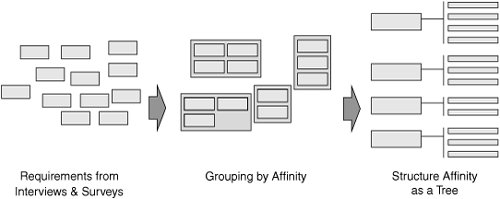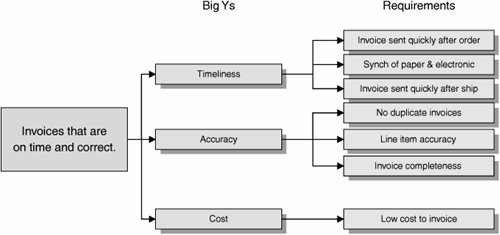Section 13. Customer Requirements Tree
13. Customer Requirements TreeOverviewA Customer Requirements Tree is the last in a series of tools used to capture the VOC. The output of any Customer Interviews, along with output from Customer Surveys, are affinitized and then translated into a Customer Requirements Tree to identify the Big Ys or KPOVs for the process. The tool is used to graphically show the major Customer Needs and associated metrics for the process, so that the Belt, Champion, and Process Owner can agree on the major metrics that the project will address. An example Customer Requirements Tree is shown in Figure 7.13.1. Figure 7.13.1. Example Customer Requirements Tree for an invoicing process.[23]
The tree helps translates broad Customer requirements into specific critical requirements and then to detailed specifications. LogisticsIt speeds up completion of the Tree if the Belt does some draft construction prior to a working session with the Team. The primary input to the Tree is the Customer Requirements Affinity Diagram, so this needs to be readily accessible during construction. A working session to construct the Tree in the Define Phase typically takes 12 hours, but often requires follow up on specific elements, which could theoretically go on well into Measure if no usable metrics exist or little is known about them. Signoff for Define, however, cannot be done until the Tree is complete and the subsequent KPOVs are defined. RoadmapThe roadmap to constructing the Customer Requirements Tree starts much earlier, with the outputs from interviews and surveys being organized logically in an Affinity Diagram as shown graphically in Figure 7.13.2. Figure 7.13.2. Construction of a Customer Requirements Tree.
Interpreting the OutputThe Customer Requirements Tree is used to identify the superset of major metrics for the process in question. Only a subset of these metrics can be efficiently tackled in a Lean Sigma process, so the Tree (in context of all the Customer Interviews and Customer Surveys) is used to guide the Belt and Champion in a discussion about what the selected target metrics should be for the project. |
EAN: 2147483647
Pages: 138
